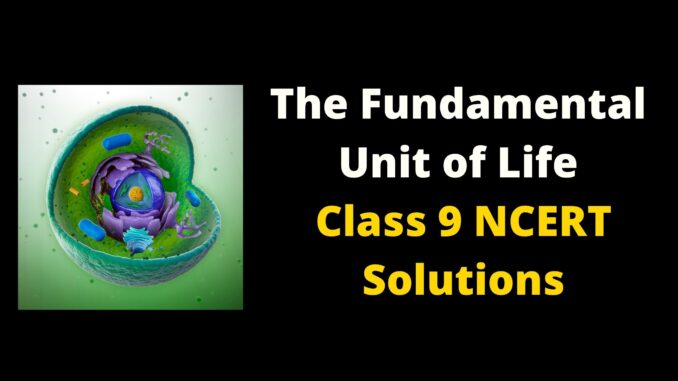
Fundamental Unit of Life is a class 9 Science chapter that talks about the cells and their structure, types of cells and discusses the cell organelles one by one. Robert Hooke discovered a cell on the cork of a tree.
The Fundamental Unit of Life NCERT Solutions
Class 9 NCERT Chapter 5 In-text Questions
Question1: Who discovered Cells and how?
Ans 1: Robert Hooke discovered cells in the year 1665. He observed cork of a tree and put it under the microscope. He saw compartments that resembled honeycombs. Now, you must be curious about Cork, Cork is obtained from the bark of a tree. So, he gave the boxes a name: Cell.
Why is a cell called the structural and functional unit of life
Cells are called the structural unit of life because all organisms are made of cells. It is called the functional unit of life because each group of cells performs different functions like digestion, respiration etc. In case of unicellular organisms, the functions are performed by a single cell Ex Amoeba
Question 1: How do substances like CO2 and water move in and out of the cell? Discuss.
Ans 1: CO2 and water move in and out of the cell with the process of diffusion. In diffusion, the substances move from a region of higher concentration to a region of lower concentration. If the external environment has a higher concentration then the substance will move inside and moves outwards if the concentration is higher inside the cell.
Question 2: Why is a plasma membrane called a selectively permeable membrane?
The Plasma membrane is called the selectively permeable membrane because it decides what substances have to enter the cell and what substances should leave the cell. It regulates the movement of substances in a selective manner.
Question 1: Can you name the two organelles we have studied that contain their own genetic material?
Mitochondria and Plastids have their own genetic material.
Question 2: If the organisation of a cell is destroyed due to some physical or chemical influence, what will happen?
If the organisation of a cell is destroyed due to some reasons then it will not be able to perform basic functions like digestion, respiration of cell and the process of removal of wastes from the cell.
Question 3: Why are lysosomes known as the suicidal bags of the cells?
Lysosomes are known as the suicidal bags of the cells because if any kind of disturbance in the cell they start digesting the cell itself with the help of release of enzymes. Slowly, the cell organelles will start destroying.
Question 4: Where are proteins synthesized in the cell?
The proteins are synthesized in the ribosomes of the cell. It is called as the main site of protein synthesis.
Fundamental Unit of Life NCERT Solutions: Back Exercise
Question 1: Make a comparison and write down ways in which plant cells differ from animal cells
| Animal Cell | Plant Cell |
|---|---|
| Cell wall is absent | Cell wall is present |
| They lack chloroplasts | Plant cells have chloroplast |
| Small size of vacuoles | Vacuoles occupy a large space of the cell |
| They have centrosomes | They do not have centrosomes |
Question 2: How is prokaryotic cell different from a eukaryotic cell?
| Prokaryotic | Eukaryotic |
|---|---|
| Prokaryotics are smaller in size | Eukarytic cells are larger in size |
| They have poorly defined nuclear region | They have well defined nuclear region |
| They have single chromosomes | They have more than one chromosome |
| Membrane bound organelles are absent | Membrane bound organelles are present in eukaryotic cells |
Question3: What would happen in plasma membrane ruptures or break down?
Ans 3: If the plasma membrane of the cell gets ruptured then the cell will not be able to exchange substances through the cell. The cell will not be able to survive and it will die soon.
Question 4: What would happen if there was no Golgi Apparatus?
Ans 4: Golgi apparatus plays an important role in the cell. Its functions are storage, modification and packaging of cellular products. Imagine will these functions be possible without the Golgi apparatus. Transporation of these substances will also not be possible.
Question 5: Which organelle is known as the powerhouse of the cell. Why?
Ans 5: Mitochondria is known as the powerhouse of the cell because it provides the energy needed by the cell for carrying out different cellular activities. The energy is stored in the form of ATP ( Adenosine Triphosphate)
Question 6: Where do the lipids and proteins constituting the cell membrane get synthesized?
Lipids are synthesized in the smooth endoplasmic reticulum (SER) whereas the proteins are synthesized in the RERs i.e. the Rough Endoplasmic Reticulum.
Question 7: How does an Amoeba obtain its food?
The Amoeba has temporary finger-like projections. it move towards the food particle and fuses over it. It engulfs the food particle and then slowly starts digesting it. The digested substances reaches the cytoplasm whereas the waste generated moves out of the Amoeba
Question 8: What is Osmosis?
Ans 8: Osmosis is the process by which water moves from a region of higher concentration to a lower concentration. The cell should have a semi-permeable membrane so that substances can easily enter and exit out of the cell. This process can also be observed in raisins when we soak them in the water overnight.

Leave a Reply